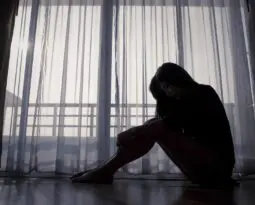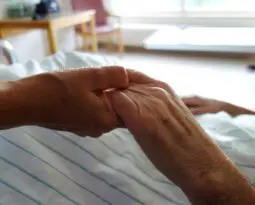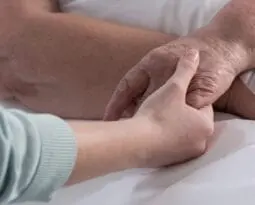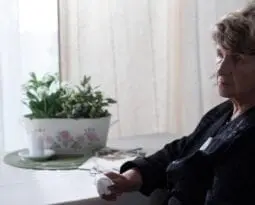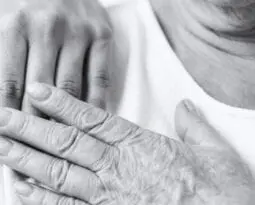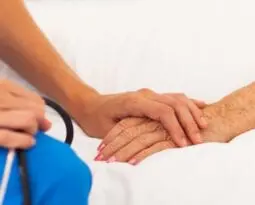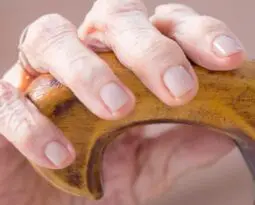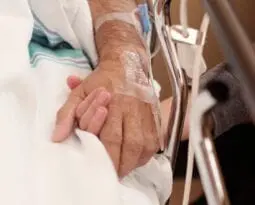Ethics and Medical Aid In Dying
Selected resources on medical aid in dying and euthanasia from The Hastings Center.
Bioethics Briefings:
This briefing is concerned mainly with medical aid-in-dying in the United States, where it is legal in several states. Only terminally-ill patients who have the capacity to request that a physician prescribe a lethal medication are eligible. Proponents and critics of physician aid in dying have different ethical reasons to support their positions. Read our briefing to consider: Are severely ill suffering patients entitled to a physician’s help to end their suffering by ending their lives?
From Hastings Bioethics Forum:
- It’s Time to Change the Conversation About MAiDIn a recent commentary, physician Alan Astrow expressed skepticism about the legalization of medical aid in dying. He cited the subjectivity of determining…
- Betty Rollin’s Assisted Death: Unanswered QuestionsNetwork news correspondent and author Betty Rollin died in November at age 87. Surprisingly, there has been little public comment upon how her life ended. Rollin died in Switzerland at Pegasos, a voluntary assisted dying service. The circumstances of her death underscore the confusion over terminology and the uneasiness some feel regarding efforts to legalize assisted dying in New York State and elsewhere in our country.
- Does Calling Severe Anorexia a Terminal Condition Matter?What is at stake in calling extreme, end-stage anorexia nervosa a terminal condition? It may be thought to have implications for end-of-life decisions. I will argue that this is a mistake, although one that needs explanation.
- Honoring My Friend’s Last WordsI’ll always feel like I missed an opportunity by sending his call to voicemail. I had no idea that this would be my last opportunity to speak with him.
- MAID Without Borders? Oregon Drops the Residency RequirementOregon, which legalized medical aid in dying (MAID) in 1997, has dropped the requirement that had limited MAID access to residents of the state. What are the ethical and social implications of this policy change?
- Is Medical Aid in Dying a Human Right? Another ViewAn essay for Bioethics Forum earlier this month concludes that medical aid in dying is not a human right. But we should have a right to decide what suffering we are willing to endure and receive medical assistance necessary to avoid the suffering we want to avoid.
- Physician-Assisted Death and Journalism EthicsA New York Times special report on euthanasia of a Paralympics champion in Belgium was ethically problematic for several reasons.
- Is Medical Aid in Dying a Human Right?The Kings County Medical Society in New York recently hosted a brunch with New York State legislators. One of the guests was Richard Gottfried, chair of the New York State Assembly Health Committee, who is cosponsoring A2694, a bill legalizing medical aid in dying (MAID). As a medical oncologist with 30 years’ experience treating seriously ill patients, I have concerns about it, and I expressed them to Gottfried.
- Should Feeling Tired of Life Be Grounds for Euthanasia?Should an elderly person in decent health but “tired of life” be able to die with a physician’s assistance? The Netherlands is grappling with this question.
- Love and Boundaries in MedicineIt’s a little-known and rarely discussed fact of medical practice that doctors value the ability to love our patients. If the thought of…
- Hawaii’s New End-of-Life Law: Do the Additional Safeguards Withstand Scrutiny?Last month, Hawaii became the seventh state, with the District of Columbia, to legalize physician-assisted suicide. Similar to some of the other state…
- Does the Future Belong to Assisted Death?I have been opposed to physician-assisted death for well over 30 years. I need to go back to my early days with this…
- Vive la Bioéthique? France’s Bioethics InitiativeLittle noticed in the United States but a big deal in France, President Emmanuel Macron announced in January that he is creating a…
- Has Physician-Assisted Death Become the “Good Death?”“Death with dignity” for the past 40 years has meant, for many people, avoiding unwanted medical technology and dying in a hospital. A…
- Neil Gorsuch, Aid in Dying, and Roe v. WadeGiven the chance, would Supreme Court nominee Neil Gorsuch vote to overturn Roe v Wade? Challenge state “death with dignity” laws?
- Is Death in Trouble?Death is beginning to show its age, though I hesitate to even mention that possibility. With an obviously big ego and its intimidating…
- Assisted-Dying Provisions: California Legislature Says Yes, the U.K. Says NoA new chapter in efforts to secure legal provisions for physician-assisted dying began last week when the California State Legislature voted to approve the End…
- Why New Zealand Should Permit Aid in DyingHaving read with interest Josephine Johnston’s essay on the aid-in-dying case before a court in New Zealand, I’d like to elaborate on some salient…
- Dying: Closing the Gap between What We Know and What We DoTime is running out on fixing the way we die. As readers of this blog know, the courts first declared a right to…
- How Brittany Maynard Changed the Conversation about Aid in DyingBrittany Maynard, the courageous 29-year-old woman with terminal brain cancer, ended her life a month ago today. She and her husband had moved to…
- Alzheimer’s Disease, Biomarkers, and Suicide: Why We Need to Think About All Three TogetherRecently, I spoke with a seasoned health care reporter who was interested in Alzheimer’s and biomarkers because of his own family’s history of…
- A Peaceful Death or a Risk to People with Disabilities?Armond and Dorothy Rudolph of New Mexico were evicted from their assisted living facility in January 2011, after administrators called the police and…
- Euthanasia in Belgium: The Untold StoryBelgian twins, Eddie and Marc Verbessem, were euthanized by lethal injection at Brussels University Hospital in Jette in December. The Verbessem brothers, deaf since birth,…
From Hastings Center Report:
Choosing to Die
First published: 13 October 2022
Abstract
Two articles in the September–October 2022 issue of the Hastings Center Report discuss health-related reasons that people might have to actively bring their lives to an end. In one, Brent Kious considers the situation of a person who, because of illness, becomes a burden on loved ones. A person in such a situation might prefer to die, and Kious argues that, while there is no obligation to hasten one’s death, the choice to do so could sometimes be reasonable. In a second article, Henri Wijsbek and Thomas Nys discuss a case in the Netherlands in which a woman with severe dementia died by euthanasia at a point when her advance euthanasia directive did not align with what she said, when asked, about death. Wijsbek and Nys defend the authority of her advance directive against a range of objections.
In a third article, Henry Silverman and Patrick Odonkor, physicians at the University of Maryland Medical Center, where physicians performed the first pig-to-human heart transplantation in early 2022, develop recommendations for clinical trials of porcine heart transplantation. And an essay in the issue criticizes the allocation recommendations developed for Covid-19 vaccines by the U.S. Centers for Disease Control and Prevention’s Advisory Committee on Immunization Practices.
On the Authority of Advance Euthanasia Directives for People with Severe Dementia: Reflections on a Dutch Case
First published: 13 October 2022
Abstract
In 2016, a Dutch physician complied with the advance euthanasia directive of a patient with severe dementia. In the ensuing lawsuit, the physician was charged principally with termination of life on request, with euthanasia, that is, and alternatively with murder. A district court acquitted her of both charges, a decision later upheld by the Dutch Supreme Court. Euthanasia remains a criminal offense in the Netherlands.
However, in 2002, policymakers implemented a new euthanasia act, permitting a physician to perform euthanasia if she meets six due-care criteria. The two most crucial criteria are ensuring the patient’s request is voluntary and well-considered and confirming that the patient’s suffering is intolerable with no prospect of improvement. Neither of these two criteria is controversial; particular cases are controversial when it is disputed that these criteria were fulfilled. Other euthanasia cases, however, are controversial because they belong to a category that is contentious for independent reasons. One such disputed category is euthanasia performed on incompetent patients with an advance directive.
Since determining whether these criteria are fulfilled in a particular case depends on the particular circumstances, we describe this 2016 case in detail. We then focus on three general philosophical reasons for doubting the validity of advance euthanasia directives for incompetent patients: the someone else problem, the problem of response shift, and the problem of normative authority. Others have discussed these problems before, but we aim to show how they are connected. Taken together, we believe that our two lines of argument make a strong moral case for supporting the Dutch Supreme Court’s decision.
Burdening Others
First published: 13 October 2022
Abstract
Many people are afraid they will, as they age or fall ill, become burdens to others. Some who fear this say they would be willing to hasten their own deaths—engaging in self-sacrifice through suicide, assisted suicide, or euthanasia—to avoid it. Still, some bioethicists and other critics of medical aid in dying reject the idea that fear of being a burden can be a good reason for self-sacrifice. They argue that dependency is nearly universal, emphasize that caregiving is a valuable pursuit, and raise concerns about the impact of aid-in-dying policies on vulnerable groups.
After defining what it is to be a burden, articulating why being a burden is morally significant, and, crucially, distinguishing burdensomeness from what I call “mere dependency,” I defend the intuition that self-sacrifice can be justified by the desire to avoid being a burden and by the concern for the well-being of one’s caregivers that this choice implies.
Death in a Cold Climate: Medical Aid in Dying in Vermont
First published: 10 February 2022
Abstract
What happened when Vermont passed its medical-aid-in-dying bill in 2013? Not what one might hope or expect. In Scripting Death: Stories of Assisted Dying in America (University of California Press, 2021), Mara Buchbinder details, through a host of gripping interviews, the difficulties people experience in actually accessing their legal rights to physician-assisted suicide.
Ending One’s Life in Advance
First published: 24 May 2021
If you developed Alzheimer disease, would you want to go all the way to the end of what might be a decade-long course? Some would; some wouldn’t. Options open to those who choose to die sooner are often inadequate. Do-not-resuscitate orders and advance directives depend on others’ cooperation. Preemptive suicide may mean giving up years of life one would count as good. Do-it-yourself methods can fail. What we now ask of family and clinicians caring for persons with dementia, and of patients given no better option than to go on with lives they may not want, is unacceptable. To explore how one might better control one’s own dying and avoid burdening others with overwhelming care and morally painful choices, we propose a thought experiment: an advance directive implant that would enable persons with early dementia, while competent, to arrange their own deaths without the subsequent intervention of anyone else.
Medically Assisted Dying and Suicide: How Are They Different, and How Are They Similar?
First published: 18 February 2020
Abstract
The practice of medically assisted dying has long been contentious, and the question of what to call it has become increasingly contentious as well. Particularly among U.S. proponents of legalizing the practice, there has been a growing push away from calling it “physician-assisted suicide,” with assertions that medically assisted dying is fundamentally different from suicide. Digging deeper into this claim about difference leads to an examination of the difference between two kinds of suffering—suffering from physical conditions and suffering from psychological conditions—and therefore leads also toward an examination of whether requests for medical assistance in dying by those suffering from psychological conditions and those suffering from physical conditions should be painted with the same brush.
In this article, I aim both to illuminate some of the considerations that ought to be included in discussions related to medically assisted dying and to shed light on what the indirect effects of such discussions can be. I consider some of the reasons commonly given for holding that suicide and medically assisted dying differ fundamentally and then whether the conclusion that medically assisted dying should not be called “suicide” follows from the premises.
I ask what else might justify the conclusion that the two acts ought to be called by different names, and I examine possible justifications for accepting this premise, as well as what justifications might exist for emphasizing how the acts are alike. Finally, I argue that we should be cautious before concluding that medically assisted dying should not be called “suicide.” We need more evidence either that the two acts are fundamentally different or that emphasizing differences between them is not likely to do more harm than good.
Dying with Dignity; Living with Laws (and Ethics)
First published: 3 July 2019
Abstract
An increasing number of jurisdictions allow individuals to obtain medication prescribed by their physicians for medical assistance in dying (MAID). But discussion of whether (and to what extent) individuals have the right to use the health care system to control the time and manner of their death is not limited to MAID. The right also exists in other contexts, such as directing the withdrawal of life-sustaining treatments.
Palliative (or terminal) sedation involves medications to render a patient unconscious, coupled with either the withdrawal of artificial nutrition and hydration or their not being administered at all. In high-enough doses, these medications may further suppress already-weakened cardiopulmonary function even if there is no intent to hasten death. When teaching about these topics, I challenge students to consider whether there are meaningful differences between practices like euthanasia, MAID, aggressive use of morphine, terminal sedation, or the withdrawal of ventilator support. Whether their differences are morally, ethically, or legally meaningful can be difficult to tease out. After recently watching a loved one, whom I call “Stephan,” direct the time and manner of his death within hospice care in a state that does not allow MAID, I am less inclined than ever to believe that the differences are meaningful in a way the law should recognize.
Requests for PAD and the Assessment of Capacity
First published: 21 February 2019
Abstract
I was asked to evaluate M by her medical oncologist, Dr. T. As a psychiatrist, I was to perform the duties of a mental health specialist in the care of this fifty-eight-year-old woman with metastatic breast cancer who had requested physician aid in dying. Dr. T had no specific concerns, but she was adhering to the letter of the law by referring the patient to me—a “mental health specialist”—because, according to the patient’s medical history, there was “evidence of a mental disorder.” That evidence was comprised of depression treated in the remote past.
Some years before California passed its End of Life Options Act in 2015, M had begun talking with Dr. T about the circumstances under which she might no longer want to be alive and might even choose to take active steps to end her life. She had fairly specific and durable criteria for knowing “when the time had come.” In our interview, she asserted very clearly that the time had not come but that, with the law now active, she hoped to have access to a lethal prescription in case it did.
Poverty: Not a Justification for Banning Physician-Assisted Death
First published: 26 December 2018
Abstract
Many critics of the legalization of physician-assisted death oppose it in part because they fear it will further disadvantage those who are already economically disadvantaged. This argument points to a serious problem of how economic considerations can influence medical decisions, but in the context of PAD, the concern is not borne out. We will provide empirical evidence suggesting that concerns about money influence medical decisions throughout the full course of illness, but at the end of life, financial pressure is much more likely to influence a decision to pursue or reject aggressive life-extending care than it is to influence a request for PAD.
We will also address the question of whether financial pressure as a result of being poor—particularly in the context of an inadequate social safety net—robs people of their autonomy, rendering their informed request and consent invalid. We argue that it does not. We will emphasize the impracticality and injustice of rejecting the role of poverty as a legitimate factor in decision-making, the irrational distinction between PAD and withdrawal of life-sustaining care, and the more appropriate focus on the great flaws in the American health care system.
Medical Aid in Dying: Bioethics as Sideshow
First published: 26 December 2018
Abstract
Twenty years ago, the passage of the Oregon Death with Dignity Act prompted vigorous debate in my bioethics classrooms; now, the issue barely generates a ripple. Instead, we focus on an issue my students’ generation will confront, as illustrated by an amendment to the ODDA introduced in the last Oregon legislative session that would have effectively rescinded two core procedural safeguards: patient decision-making capacity when requesting life-ending medication and self-administration of the medication. Patient requests for medication could be stipulated on an advance directive that appoints an “expressly identified agent” authorized, in the event of loss of decision-making capacity, “to collect and to administer to the patient the prescribed medication.”
The amendment heralds a shift from physician-assisted death to medical aid in dying and from prescriptions ingested by patients to life-ending medication administered by a physician or even by the patient’s “agent.” This prospect generates a bit more angst amongst my students, but their acculturation in the ethics of individual choice prevails. Our discussion about the ethics of medical aid in dying inescapably turns to a deeper issue: is there a professional ethos independent of autonomy?
An Open Letter to Norman Cantor Regarding Dementia and Physician-Assisted Suicide
First published: 16 August 2018
Abstract
Dear Norm,
Thank you for sharing such a personal and heartfelt essay. I have been asked by the editors to comment. Reading it inspires me to do so in a similarly heartfelt way. Although I don’t know you well, I thought I’d write to you as if you were my patient.
I share your sense that Alzheimer disease is a terrible scourge. I’ve seen much of this disease over a lifetime of practice, and I deeply understand its ravages and the debility and suffering it causes. But what you propose is not a good solution for the problems that Alzheimer disease poses for patients, families, and society. It will ultimately do far more harm than good. Please let me try to explain.
Physician-Assisted Death and Severe, Treatment-Resistant Depression
First published: 20 September 2017
Abstract
Should people suffering from untreatable psychiatric conditions be eligible for physician-assisted death? This is possible in Belgium and the Netherlands, where PAD for psychiatric conditions is permitted, though rare, so long as the criteria of due care are met. Those opposed to all instances of PAD point to Belgium and the Netherlands as a dark warning that once PAD is legalized, restricting it will prove impossible because safeguards, such as the requirement that a patient be terminally ill, will inevitably be eroded or discarded.
However, some supporters respond that limiting PAD to those suffering from terminal illness, or physical illnesses generally, is arbitrary and illogical. In addition, precisely because such patients are not terminally ill, their suffering may last for years, even the rest of their lives. Finally, severe depression may not be treatable. If PAD is justifiable under some conditions—as I shall assume in this article—then why wouldn’t it be justifiable for these patients? Why shouldn’t psychiatrists who have nothing else to offer their suffering patients be able to help them to die, if that is what they want?
On Legalizing Physician-Assisted Death for Dementia
First published: 27 July 2017
Abstract
Last November, soon after Colorado became the latest state to authorize physician-assisted suicide, National Public Radio’s The Diane Rehm Show devoted a segment to legalization of “physician assistance in dying,” a label that refers to both physician-assisted suicide and voluntary active euthanasia.
Although the segment initially focused on PAD in the context of terminal illness in general, it wasn’t long before PAD’s potential application to dementia patients came up. A caller said that her mother had Alzheimer’s disease and was being cared for at great expense. Suspecting that she will suffer the same fate, the caller reported that she had included in her will “my specific request that if I should be diagnosed, and it is legal to do so, I would like to opt out of a life and many years of suffering.” A few countries, such as the Netherlands and Belgium, already allow PAD for dementia in certain circumstances. It wouldn’t be surprising to see a U.S. legalization effort in the coming years.
Implementing California’s Law on Assisted Dying
First published: 16 March 2017
Abstract
On October 5, 2015, Governor Jerry Brown approved bill ABX2 15, the End of Life Option Act, making California the fifth state in the country to allow physician-assisted dying. The law was modeled after Oregon’s 1997 Death with Dignity Act. When the legislative special session ended on March 10, 2016, California health care providers had only ninety days to respond to the state mandate before the law would take effect, on June 9, 2016. Experience with the law so far suggests several challenges with implementation.
International Perspectives on Physician Assistance in Dying
First published: 22 November 2016
Abstract
When the Supreme Court of Canada recognized a constitutional right to “medical assistance in dying” last year—and the nation’s Parliament enacted legislation to implement the right earlier this year—Canadian lawmakers could look to two different models for guidance. The Netherlands and Belgium recognize a broad right to assistance in dying, while Oregon and elsewhere in the United States have a narrow right.
In some ways, assistance in dying in Canada follows the Dutch-Belgian approach, while, in other ways, it seems more American. Two societal factors seem relevant to the different approaches: the role that religion plays in people’s lives and the trust that people place in their governments and health care systems. As other governments consider legalizing assistance in dying, an important question is whether some restrictions on the right are particularly critical. The experience to date suggests that requiring patients to be terminally ill has provided the best protection against misuse.
“Isn’t that euthanasia?”
First published: 10 March 2016
Abstract
Grounded in the principle of autonomy, withdrawal of life-sustaining measures is now widely accepted in the United States when performed in accordance with patient preferences and interests. Deactivating a pacemaker in a pacer-dependent patient is an instance of withdrawing a life-sustaining measure; whether it is morally permissible rests largely on whether the patient in question would want it done.
“Aid in Dying” in the Courts
First published: 5 May 2015
Abstract
Three states—Oregon, Washington, and Vermont—have used straightforwardly democratic means to legalize the practice formerly known as “physician-assisted suicide” but now termed “aid-in-dying.” In two states—Montana and New Mexico—aid-in-dying has been declared legal neither by directly democratic action by citizens nor by representatively democratic action by the legislature but by court rulings in cases brought by aid-in-dying activists. The court case in New Mexico (Morris v. New Mexico, 2014) is undoubtedly of greater significance to the rest of the states. The Morris opinion is as interesting for what it declined to hold as for what it held.
Death, State by State
First published: 9 July 2014
Abstract
Although bioethicists do not always recognize it, death is not defined uniformly in the United States. It is defined primarily in state law, and as with any legislative effort that proceeds state by state, results may vary.
On the Difference between Physician-Assisted Suicide and Active Euthanasia
First published: 23 March 2012
Abstract
Those who defend physician-assisted suicide often seek to distinguish it from active euthanasia, but in fact, the two acts face the same objections. Both can lead to abuse, both implicate the physician in the death of a patient, and both violate whatever objections there are to killing. Their moral similarity derives from the similar roles of the physician.
Why Does Removing Machines Count as “Passive” Euthanasia?
First published: 23 March 2012
Abstract
The distinction between “passive” and “active” euthanasia, though problematic and highly criticized, retains a certain intuitive appeal. When a patient is allowed to die, nature appears simply to be taking its course.
Yet when a patient is killed by, say, a lethal injection, humans appear to be causing his or her death. Guilt seems to follow naturally from the latter act while not from the former. Yet this view only holds up if age-old and vague ideas about “nature” and “artifice” go unscrutinized. Once examined more closely the functional relevance of particular machines to particular bodies becomes evident. And the innocence and guilt less clear.
Physician Assistance in Dying: A Subtler Slippery Slope
First published: 14 March 2012
Abstract
Shortly after discharge, my patient’s husband called to inform me that his wife had died suddenly the previous evening. The call was not a surprise. I felt she had silently communicated to me that she was taking matters into her own hands, and the quantity of narcotics I prescribed was enough to be lethal if ingested as a single dose. I was aware that this was a possible and perhaps even likely outcome. I could have limited the drug amount, but this would have required that she return frequently to the clinic. I believed that such restrictions were an affront to her dignity and her autonomy. And she could always stockpile her drugs to achieve the same purpose.
In the midst of the ongoing contretemps surrounding the legality of physician-assisted death, there is a grey zone of physician complicity. My action in providing my patient with a potentially lethal quantity of narcotics certainly marks me as an assistant, albeit at a remove, in her suicide.
Making Sense of the Roman Catholic Directive to Extend Life Indefinitely
First published: March 2011
Abstract
In November 2009, the U.S. Conference of Catholic Bishops issued “Ethical and Religious Directives for Catholic Health Care Services,” requiring that all patients—including those in the so-called persistent vegetative state—be provided with artificial hydration and nutrition if such care could extend life indefinitely. The directives prompted outcry from death-with-dignity movements and confusion within hospital ethics committees. These discussions raise several questions with direct bearing on patient care: Do the bishops have authority over Roman Catholic health care institutions? Do the bishops’ directives represent a departure from—or even a radicalization of—traditional Catholic teaching? How might these directives change clinical practice?
Baxter and the Return of Physician-Assisted Suicide
First published: November 2010
Abstract
A recent development in Montana has altered the physician-aid in dying landscape somewhat. The Montana Supreme Court decided Baxter v. Montana, a case that most observers thought would clarify the status of physician-assisted suicide under Montana’s constitution. It decided instead whether a physician who participates in a physician-assisted suicide in Montana—and does so in accordance with the rules that have been developed for this practice in Oregon and Washington—could lawfully be convicted of violating Montana’s homicide statute after the patient died from taking the medicine that the physician prescribed. The court concluded that the physician could not be convicted of violating the homicide statute because the physician would always be able to assert the consent of the patient in question as a complete defense.
Hospice and Physician-Assisted Death
First published: September 2010
Abstract
Although the overwhelming majority of terminally ill patients in Oregon who seek a physician’s aid in dying are enrolled in hospice programs, hospices do not take a major role in this practice. An examination of fifty-five Oregon hospices reveals that both legal and moral questions prevent hospices from collaborating fully with physician-assisted death.
Assisted Suicide in the U.K.: From Crime to Right?
First published: May 2010
Abstract
With the Suicide Act of 1961, British Parliament formally decriminalized the act of suicide. It also asserted that while providing assistance in another person’s suicide attempt should remain a criminal offense, no prosecution could be brought for assisting a suicide except by, or with the consent of, the Director of Public Prosecutions. The law has remained formally the same in the intervening fifty years. Unfortunately, judicial alchemy in the last year has radically altered the law’s social and moral significance, transforming what had unequivocally been a crime subject to condemnation into a right worthy of respect.
Dying with Dignity
First published: March 2010
Abstract
As used by those who want to legalize assisted suicide, “death with dignity” implies that people who are dying are not already dignified. They are.
Organized Obfuscation: Advocacy for Physician-Assisted Suicide
First published: September 2008
Abstract
The advocates for physician-assisted suicide make use of a favorite method from the spin tool box, that of obfuscation, defined in dictionaries as an effort to render something unclear, evasive, or confusing. I believe that in recent years, many (though hardly all) advocates of euthanasia and physician-assisted suicide have used organized obfuscation as a political tactic, and the ballot initiative in Washington is no exception.
Terminal Sedation: Pulling the Sheet over Our Eyes
First published: September 2008
Abstract
Terminal sedation—also called “palliative sedation,” “continuous deep sedation,” or “primary deep continuous sedation”—has become a new favorite in end-of-life care, a seeming compromise in the debate over physician-assisted dying. Like all compromises, it offers something to each side of a dispute. But it is not a real down-the-middle compromise. It sells out on most of the things that may be important—to both sides. To corrupt an already awkward metaphor, terminal sedation pulls the sheet over our eyes.
Confronting Physician-Assisted Suicide and Euthanasia: My Father’s Death
First published: September 2008
Abstract
My father’s death forced me to rethink all I had written over two decades opposing legalization of physician-assisted suicide and euthanasia.
Two Pioneers of Euthanasia around 1800
First published: May 2008
Abstract
It is undoubtedly true that active euthanasia moved into the center of a lively controversial debate only in the late nineteenth and early twentieth centuries. But at least two well-known German physicians already publicly endorsed active euthanasia around 1800. Their stance must be understood within the rather special context of German medicine and society at that time.
“Doctor, Will You Turn Off My LVAD?”
First published: January 2008
Abstract
As a result of severely debilitating stage IV heart failure, doctors implanted a Left Ventricular Assist Device into Mr. P’s chest as so-called destination therapy. After three months at home, Mr. P has asked to be readmitted to the hospital so that doctors can disable his LVAD. He understands that he will likely die within hours after the device is turned off, but he no longer wishes to live in his current state. Should Mr. P’s physicians accede to his request and disable his LVAD?
Not DEA’d Yet: Gonzales v. Oregon
First published: March 2006
Abstract
In Gonzales v. Oregon, the U.S. Supreme Court (by a six-to-three vote) affirmed decisions of two lower federal courts and made permanent a 2001 injunction against federal prosecution of physicians who prescribe narcotics under the terms of the act. Media coverage of the decision both exaggerated and underplayed the decision’s significance.
Vitalism Revitalized: Vulnerable Populations, Prejudice, and Physician-Assisted Death
First published: July 2002
Abstract
One of the most potent arguments against physician-assisted death hinges on the worry that people with disabilities will be subtly coerced to accept death prematurely. The argument is flawed. There is nothing new in PAD: the risk of coercion is already present in current policies about end-of-life care. And to hold that any such risk is too much is tacitly to endorse vitalism and to deny that people with disabilities are capable of choosing authentically.
Restricting Physician-Assisted Death to the Terminally Ill
First published: November 2000
Abstract
Although physician-assisted death can be a great benefit both to those who are terminally ill and those who are not, the risks for patients in these two categories are quite different. For now it is reasonable to make the benefit available only for those near death, and to await better evidence about the risks before making it more broadly available.
Physician-Assisted Suicide: Promoting Autonomy—Or Medicalizing Suicide?
First published: May 1999
Abstract
Assisted suicide, many argue, honors self-determination in returning control of their dying to patients themselves. But physician assistance and measures proposed to safeguard patients from coercion in fact return ultimate authority over this “private and deeply personal” decision to medicine and society.
Should Psychiatrists Serve as Gatekeepers for Physician-Assisted Suicide?
First published: July 1998
Abstract
Mandating psychiatric evaluation for patients who request physician-assisted suicide may not offer the clearcut protection from possible coercion or other abuse that proponents assert. Competence itself is a complex concept and determinations of decision-making capacity are not straightforward, nor is the relationship between mental illness and decision-making capacity in dying patients clearly understood. And casting psychiatrists as gatekeepers in end-of-life decisions poses risks to the profession itself.
What Happens Now?: Oregon and Physician-Assisted Suicide
First published: May 1998
Abstract
With assisted suicide now legally sanctioned, health care professionals in Oregon face the challenge of implementing Oregon’s Death with Dignity Act. Physicians, hospice professionals, pharmacists, and other caregivers may find their relationships with patients, families, and fellow professionals changing in unanticipated ways as all learn what it means to make aid in dying openly and compassionately available to patients at the end of life.
Professional Integrity and Physician-Assisted Death
First published: May 1995
Abstract
The practice of voluntary physician-assisted death as a last resort is compatible with doctors’ duties to practice competently, to avoid harming patients unduly, to refrain from medical fraud, and to preserve patients’ trust. It therefore does not violate physicians’ professional integrity.
Selling Death and Dignity
First published: May 1995
Abstract
Advocates use case descriptions to show that euthanasia or assisted suicide is sometimes justifiable. Yet even the seemingly clearest cases can prove deeply troubling.
The Constitution and Hastening Inevitable Death
First published: September 1993
Abstract
The due process clause of the Fourteenth Amendment protects the right of terminally ill persons to hasten their inevitable death. In prohibiting physicians from prescribing lethal medications by which such patients might hasten death, Michigan’s ban on “assisted suicide” unconstitutionally imposes an “undue burden” on the exercise of that right.
From The Hastings Center Bioethics Timeline:
1984: Decision against Prosecution for Mercy Killing in the Netherlands
Accepted by the Dutch Supreme Court in the 1984 Alkmaar Case, the Court recognized an agreement negotiated by Dutch prosecutors and the Royal Dutch Medical Society that allowed a physician to avoid prosecution for euthanasia—prescribing a fatal dose of medication to a dying patient—provided that the physicians informed prosecutors of the details involving their euthanasia of a patient.
1990: Jack Kevorkian Assists in Medical Death (by Suicide) of Janet Adkins
Jack Kevorkian, MD, a Michigan pathologist and advocate for euthanasia and medically assisted death, used a “machine” he had created that allowed Janet Adkins, a 54-year-old Alzheimer’s patient from Oregon, to self-administer thiopental, automatically followed by potassium chloride, causing cardiopulmonary arrest. In due time, Dr. Kevorkian would be acquitted of criminal charges from his actions in this case and in three other subsequent prosecutions. According to his attorney, he had been involved in 130 similar deaths. Dr. Kevorkian was successfully prosecuted for second degree homicide after he had directly administered medication to cause the death of Atrophic Lateral Sclerosis (ALS) patient Thomas Youk in 1998. Dr. Kevorkian died in 2011, four years after his release from prison.
https://www.nytimes.com/2011/06/04/us/04kevorkian.html.
1991: Publication of Derek Humphry’s Final Exit: The Practicalities of Self-Deliverance and Assisted Suicide for the Dying
Humphry, co-founder of the Hemlock Society and Final Exit Network, published a best-selling how-to manual of techniques in nonmedical assistance in suicide for the dying, along with descriptions of applicable laws.
D. Humphry, Final Exit: The Practicalities of Self-Deliverance and Assisted Suicide for the Dying (New York: Dell Publishing, 1991).
1994: Oregon Death with Dignity Act
Oregon Ballot Measure 16 (Death with Dignity) passed 51.3% (vs. 48.7%), after injunction for challenges, enacted in 1997 in Death with Dignity Act (ORS 127.800-995). The Death with Dignity Act became the first law allowing medical assistance in dying in the United States. The law restricted the procedure to competent patients with a terminal condition and a prognosis of less than 6 months. Also, the law required patients to make a written request followed by a 15-day waiting period, with an additional 48-hour waiting period for the medications to be dispensed.
Oregon’s 20-year experience with the procedure has shown that less than 4/1,000 patients who die avail themselves of the law, that the top reasons for use of the law include loss of autonomy (91%), loss of activities enjoyed (90%), loss of dignity (76%), loss of bodily functions (46%), and being a burden for family, friends, caregivers (44%); lesser reasons include pain (26%), with finances (4%) uncommonly a concern. Terminal patients rarely move to Oregon to use the law because of the six month residency requirement before the law can be employed.
1997: U.S. Supreme Court Case—Vacco v. Quill
In Vacco v. Quill, Dr. Timothy Quill and other physicians and three seriously ill patients challenge the constitutionality of New York State’s ban on physician-assisted suicide. The Supreme Court holds that the U.S. Constitution does not guarantee the right to die, and the Equal Protection Clause of the 14th Amendment does not protect physician-assisted suicide as a constitutional interest. The Court affirms that New York’s ban on physician-assisted suicide is rationally related to a legitimate state interest. The Court also concludes that there is a legal distinction between letting a patient die and making that patient die.
Vacco v. Quill, 521 U.S. 793 (1997). https://supreme.justia.com/cases/federal/us/521/793/
1997: U.S. Supreme Court Case-Washington v. Glucksberg
In the Washington v. Glucksberg case, Dr. Harold Glucksberg with other physicians, three terminally ill patients, and a nonprofit organization that counseled individuals contemplating physician-assisted suicide challenge Washington State’s ban on physician-assisted suicide. Glucksberg argues that Washington’s ban on physician-assisted suicide violates the Fourteenth Amendment’s Due Process Clause by denying mentally competent, terminally ill adults the liberty to choose death over life. The Supreme Court holds that Washington’s prohibition against causing or aiding a suicide does not violate the Due Process Clause.
Washington v. Glucksberg, 521 U.S. 702 (1997). https://supreme.justia.com/cases/federal/us/521/702/case.pdf/
1997: Implementation of Oregon’s Death with Dignity Act
Oregon became the first state to pass a law allowing physicians to prescribe medications for self-administration by terminally ill patients to hasten their death, sometimes called physician-assisted dying or medical aid-in-dying. The Act passed in 1994 and went into effect after Oregonians rejected a ballot measure in 1997 that aimed to repeal the law.
The Act withstands multiple attempts to nullify it, both legislatively, in the Oregon legislature and the U.S. Congress, and in federal courts. In 2006, the U.S. Supreme Court rules that Oregon physicians can prescribe life-ending medication under the Act. Over time, the Oregon experience shows that death with dignity accounts for a very small percentage of deaths. Data do not support the concerns about medical aid-in-dying being forced on vulnerable adults.
1998: Dr. Jack Kevorkian Charged
Dr. Jack Kevorkian, a trained pathologist, started providing death counseling in the late 1980s. His first public assisted suicide occurred in 1990 and involved Janet Adkins, a 54-year-old woman with Alzheimer’s disease. Kevorkian reportedly assists in the deaths of more than 100 terminally ill people. In each of these cases, the individuals themselves allegedly take the final action which resulted in their own deaths. Courts tried Kevorkian four times for assisting suicides without conviction. In the November 22, 1998 broadcast of CBS News (60 Minutes) Kevorkian allows the airing of a videotape which depicts him voluntarily euthanizing Thomas Youk, a 52-year-old man with end-stage Lou Gehrig’s disease. In this case, Kevorkian administered the lethal injection. As a result, he is charged with second-degree murder and possessing/delivering a controlled substance. He is found guilty and is sentenced to serve 10 to 25 years in prison.
https://www.ncbi.nlm.nih.gov/pmc/articles/PMC1174693/
2015: Legality of Assistance in Dying in Canada
The Carter vs. Canada case opens Canada to medical assistance in dying (MAID) when the British Columbia Supreme Court strikes down the prohibition against assisted dying and allows a patient with amyotrophic lateral sclerosis to request assistance before she becomes too disabled to die by suicide on her own.
Carter v. Canada (AG), 2015 SCC 5. https://www.justice.gc.ca/eng/rp-pr/other-autre/ad-am/p1.html
2016: Canada Legalizes Euthanasia
Canadian parliament passes bill C-14, legalizing medical aid in dying, including euthanasia, in cases of mentally competent adults experiencing “enduring and intolerable suffering” and in cases where death is “reasonably foreseeable.” The quoted phrases will become issues for subsequent litigation.
2016: Colorado Legalizes Medical Aid in Dying
Colorado becomes the 6th U.S. state to legalize medically assisted dying, passing a ballot initiative. Colorado’s initiative is unique in that it precludes hospitals and health systems from punishing physicians from participating in the aid-in-dying process, which becomes a contentious issue for religiously-affiliated health systems.
2016: Belgium Allows Euthanasia of Minors
Belgium allows the first minor to undergo legal euthanasia in that country, following adoption of a revised law in 2014 that expanded access to euthanasia in Belgium to people of all ages.
2018: Canadian Reports on Controversies in Assisted Dying
Canadian parliament receives three expert panel reports on medical aid in dying from the Council of Canadian Academies, exploring the possibility of extending medical assistance in dying to mature minors, people with psychiatric conditions, and those making requests in advance. These reports followed on the highly-publicized case of Audrey Parker, a Nova Scotia woman who chose to end her life earlier than she would have wanted for fear that she might lose mental capacity if she waited.
https://www.cbc.ca/news/canada/nova-scotia/audrey-parker-canada-assisted-dying-fix-halifax-1.5006445
2019: New Jersey and Maine Legalize Assisted Dying
New Jersey and Maine become the 9th and 10th U.S. jurisdictions to allow medical aid in dying, respectively.


